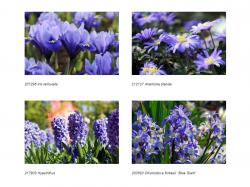The Top 8 Blue Flowers
November 14, 2018 | 2 min to read

It’s the latest trend: having blue flowers in your garden. But why, actually? And how can you create masses of blue flowers in your garden without having to change too many things around?
A preference for blue flowers
Blue is the color of willpower and faith. Adding this color to your surroundings encourages both inspiration and repose. What a color can do is rather surprising. So it’s also not surprising that people have a preference for blue flowers in their garden. But the question is: how can you accomplish this without having to make big changes in your garden? Answer: plant flower bulbs! They can start transforming your garden into a sea of blue flowers even early in the spring.
Adding them
Flower bulbs will easily grow in between perennials and shrubs that don’t yet produce leaves or flowers in early spring. And some of them will also perform just as well beneath trees. This makes it possible to add flower bulbs without having to make drastic changes in your garden – and still enjoy blue flowers. Many kinds of flower bulbs produce blue flowers. And many of these will also emerge and flower for years to come, so you can enjoy them even longer!
The top 8
To help you get started, here is a list of the top 8 flower bulbs that produce blue flowers. Simply choose what you think are the prettiest for your own garden. Which are your favorites?
- Dwarf iris (Iris reticulata)
- Anemone (Anemone blanda)
- Hyacinth (Hyacinthus varieties)
- Glory-of-the-Snow (Chionodoxa varieties)
- Striped squill (Puschkinnia libanotica)
- Grape hyacinth (Muscari varieties)
- Siberian squill (Scilla siberica)
- Crocuses (Crocus varieties)
Planting
Once you have purchased your flower bulbs, there comes a time to plant them in the garden or in pots. The best period for this is September through December. Just be sure to get the bulbs planted before the soil starts to freeze.
Step 1
Remove weeds and small stones and then work some garden mold into the soil to improve drainage.
Step 2
Dig a hole for a group of flower bulbs or make individual holes for planting single flower bulbs. The size of the flower bulb determines how deep it should be planted. Large flower bulbs (2 inches or larger in diameter) should be planted 6 inches deep and small flower bulbs (1 – 2 inches) 3 to 4 inches deep.
Step 3
Place the flower bulbs gently into the soil with the point on top. Be careful not to press down too hard on the flower bulbs, because this could damage them. Large flower bulbs should be planted 3 to 8 inches apart and small bulbs 1 to 3 inches apart.
Step 4
Cover the flower bulbs with the soil dug from the hole.
Step 5
the soil is dry, give the flower bulbs some water.
More information about flower bulbs is available at www.bulb.com.
Source: iBulb
